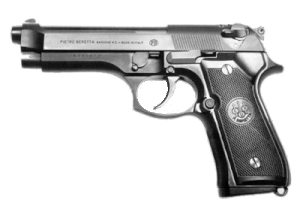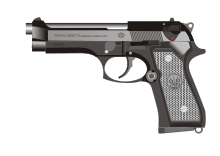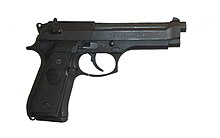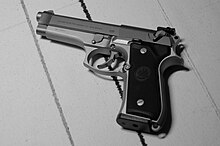Beretta 92
| Beretta 92 | |
|---|---|
 Beretta 92fs | |
| Type | Semi-automatic pistol |
| Place of origin | Italy |
| Service history | |
| In service | 1975 – present |
| Used by | See Users |
| Production history | |
| Manufacturer | Fabbrica d'Armi Pietro Beretta |
| Produced | 1975–present |
| Variants | See Variants |
| Specifications | |
| Mass |
|
| Length |
|
| Barrel length |
|
| Cartridge |
|
| Rate of fire | 40 RPM |
| Muzzle velocity | 381 m/s (1,250 ft/s) |
| Effective firing range | 50 m (160 ft) |
| Feed system | Detachable box magazine:
|
The Beretta 92 (also Beretta 96 and Beretta 98) is a series of semi-automatic pistols designed and manufactured by Beretta of Italy. The model 92 was designed in 1972 and production of many variants in different calibers continues today. The United States Armed Forces replaced the Model 1911A1 .45 ACP pistol in 1985 with the military spec Beretta 92F, the M9.
Beretta currently produces the pistol in four different configurations (FS, G, D and DS) and four calibers: 9×19mm Parabellum, .40 S&W, 9×21mm IMI and 7.65mm Luger.
History
The Beretta 92 pistol evolved from earlier Beretta designs, most notably the M1922 and M1951. From the M1922 comes the open slide design, while the alloy frame and locking block barrel (originally from Walther P38) were first used in the M1951. The grip angle and the front sight integrated with the slide were also common to earlier Beretta pistols. What were perhaps the Model 92's two most important advanced design features had first appeared on its immediate predecessor, the 1974 .380 caliber Model 84. These improvements both involved the magazine, which featured direct feed; that is, there was no feed ramp between the magazine and the chamber (a Beretta innovation in pistols). In addition, the magazine was a "double-stacked" design, a feature originally introduced in 1935 on the 9mm FN/Browning "Hi-Power".[1]
Carlo Beretta, Giuseppe Mazzetti and Vittorio Valle, all experienced firearms designers, contributed to the final design in 1975.[2]
92
Production began in May 1976, and ended in February 1983. Approximately 7,000 units were of the first "step slide" design and the rest were of the second "straight slide" type. The total production of both designs was 52,000 pistols.[3]
92S
In order to meet requirements of some law enforcement agencies, Beretta modified the Beretta 92 by adding a slide-mounted combined safety and decocking lever, replacing the frame mounted manual thumb safety. This resulted in the 92S which was adopted by several Italian law enforcement and military units. The later relocation of the magazine release button means these models (92 & 92S) cannot necessarily use later magazines, unless they have notches in both areas.[4]
92SB (92S-1)
The 92SB, Initially called the 92S-1, was specifically designed for the USAF (US Air Force) trials (which it won), the model name officially adopted was the 92SB. It included the changes of the 92S, added a firing pin block (thus the addition of the "B" to the name), and relocated the magazine release catch from the bottom of the grip to the lower bottom of the trigger guard. A compact version with a shortened barrel and slide and 13-round magazine capacity known as the 92SB Compact was manufactured from 1981 to 1991.[4]
92F (92SB-F)/92G
Beretta modified the model 92SB slightly to create the 92SB-F (the "F" added to denote entry of the model in U.S. Government federal testing) and, later, the 92G for French Government testing, by making the following changes:
- Design of all the parts to make them 100% interchangeable to simplify maintenance for large government organizations.
- Modified the front of the trigger guard so that one could use finger support for easier aiming.
- Recurved the forward base of the grip to aid aiming.
- Hard chromed the barrel bore to protect it from corrosion and to reduce wear.
- New surface coating on the slide called Bruniton, which allegedly provides better corrosion resistance than the previous plain blued finish.[5]
92FS
The FS has an enlarged hammer pin that fits into a groove on the underside of the slide. The main purpose is to stop the slide from flying off the frame to the rear if it cracks. This was in response to reported defective slides during U.S. Military testing.[6]

92A1 and 96A1
The 92A1 was introduced in 2010, based on elements of 92FS and 90two. The overall shape and styling builds on the 92FS, with an accessory rail on the underside of the frame; internal design reflects the 90two. Model 96A1 is a 92A1 variant chambered for .40 S&W.[7] The A1 models utilize a heavier slide construction combined with a slightly altered frame to accommodate the slide and tactical light rail. While most internal components are compatible with the standard and Brigadier models, the slide and frame of the 92A1 and 96A1 are not compatible the non A1 models.
Design

The Beretta 92's open slide design ensures smooth feeding and ejection of ammunition and allows easy clearing of obstructions. The hard-chromed barrel bore reduces barrel wear and protects it from corrosion. The falling locking block design provides good accuracy and operability with suppressors due to the in-line travel of the barrel. This is in contrast to the complex travel of Browning designed barrels. The magazine release button is reversible with simple field tools. Reversing the magazine release makes left-handed operation much easier.

Increasingly, it has become popular to reduce handgun weight and cost and increase corrosion resistance by using polymers. Starting around the year 2000, Beretta began replacing some parts with polymer and polymer coated metal. Polymer parts include the recoil spring guide rod which is now also fluted, magazine floor plate, magazine follower and the mainspring cap/lanyard loop. Polymer coated metal parts include the left side safety lever, trigger, and magazine release button.[8]
The also spawned several variants of similar internal design. The Beretta 90two is a full-size variant of the 92-series with a redesigned slide and a redesigned aluminum frame with an internal recoil buffer, user changeable monogrips and an accessory rail.[9]
Variants

The Beretta 92 is available in many configurations each with a distinct model name. Combining the various options results in more than 50 different configurations, but the major variants are defined by their operation caliber (92/96/98), operation (F/G/D) and combination of optional items (Inox/Brigadier slide/Compact length):
Calibers
Each model name starts with two digits identifying the caliber:
- 92: Chambered for the 9×19mm Parabellum.
- 93R: Chambered for the 9×19mm Parabellum as above, but capable of semi-auto, or three round burst. The pistol was originally equipped with a 13-round magazine and a 20-round magazine, as well as detachable butt stock. The "R" stands for "Raffica", which is Italian for "burst".
- 96: Chambered for the .40 S&W, introduced in 1990.
- 98F: Chambered for 9×21mm IMI. This option was introduced in 1987 for markets where it is illegal to own a weapon chambered for a military cartridge such as 9×19mm; essentially, this is the case of Italy. There were also about 5000 early 98F manufactured in 7.65×21mm Parabellum.
Operation
- F Models
- Also known as the 92SB-F, the model 92 F (adopted by the US Army as the M9 Pistol) has a double-action first trigger pull, followed by a single-action trigger pull for subsequent rounds. The "F" and "FS" models have a safety lever that also functions as a decocking lever.
- G Models
- The G models (designed for the French "Gendarmerie Nationale") were adopted by the French Military as PAMAS; they feature a manual decocking lever only instead of the safety-decocking lever of the 92 FS. When the decocking lever is released, it automatically returns to the ready to fire position. There is no manual safety.
- DS Models
- The DS models are "double action only" pistols: the hammer always follows the slide forward to come to rest in the double action position (the hammer never stays cocked). The hammer spur has been removed, and is flush with the rear of the slide. The manual safety lever on the slide provides the same function as it does on the 92 FS.
- D Models
- The D models are also "double action only" pistols. They are identical to the DS models but without the manual safety (the lever has also been eliminated).
- Centurion Models
- These pistols offer the frame (and same magazine capacity) of the basic 92 FS model and the reduced length of the Compact version. Special G Centurion, DS Centurion and D Centurion models are available in some countries.
- Competition Conversion Kit Models
- The standard model can be converted with a special conversion kit into a competition target pistol. The kit includes a 7.3 in (190 mm) barrel with counterweight and elevated front sight, a fully adjustable target rear sight and ergonomic walnut grips.
- Target Models
- Designed for competition shooting, these models meet all U.I.T.S. standards for large caliber pistols (P.G.C.). They differ from basic 92 FS in the following aspects: 150 mm (5.9 in) barrel, with aluminum counterweight sleeve, fully adjustable target rear sight, ergonomic walnut grips with "orange peel" anti-slip finish.
- Inox Models
- The Inox models (an abbreviation of "inoxidizable", referring to the stainless nature of "stainless steel") feature the following parts made in stainless steel: the barrel, the slide (including the extractor, the safety and the right-side manual safety lever), the trigger (and trigger pin), and slide stop lever.
Options
- Brigadier
- (1993 to present)
- 60-gram (2.1 oz) heavier slide and 1 millimetre (0.039 in) wider to improve control when firing multiple shots in quick succession. It also includes removable front and rear sights.
- Wilson Combat 92G Brigadier Tactical
- (2014 to present)
- Made in collaboration with Wilson Combat.,[10] these pistols differ from the standard Brigadier in that they have a military standard 1913 picatinny rail, all steel controls (as opposed to the polymer coated steel), decock only feature (G-model), 4.7" target crowned barrel, fluted steel guiderod, thin profile G-10 grips, rounded trigger guard, the lighter hammer spring used in the "D" model, Elite II hammer, and their own unique serial number with a "WC" prefix among other features.

- Elite I
- (1999–2001)
- Pistols with this option include the heavier Brigadier bruniton slide with front serrations and Elite designation, Inox finish (silver) stainless barrel, thin skeletonized hammer, and bevel of the magazine well. A flat hammer spring cap was standard as well as the decock only (G-Model) feature and dovetailed front sight. It was introduced in 1999 and replaced by the Elite II option in 2001.
- Elite IA
- (2001)
- This option is essentially a black Vertec with a bruniton Brigadier G slide having the Elite 1A designation and a thicker skeleton hammer. The 4.7 in (120 mm) stainless barrel with Inox finish was also changed to the blackened stainless version like black Vertecs.
- Elite II
- (2001)
- This option replaced the Elite I option in 2001 and includes the same features as the original Elite plus removable Novak type sights, extended magazine release catch, checkered front/rear grip strap, thicker (than Elite I) skeletonized hammer, and lighter D-spring. This option is available only with the stainless G-Model slide, also with front serrations. The stainless barrel for the Elite II has a target crown.


- Inox
- (present)
- Stainless barrel and slide (frame anodized to match color). Can have either black or stainless controls.
- Compact L
- (1992–)
- Shorter barrel, slide, and more compact frame (13-round magazine capacity).
- Compact Type M
- (1992–)
- Similar to the Compact L, but has a slimmer grip that accepts only a single stacked 8-round magazine.
- Centurion
- (1992–1998)
- Shorter barrel and slide (like "Compact"), but with standard-sized frame that has a slightly shorter dust cover.
- CB
- (1992–1993)

- Single action only. It is designed for sport shooting and includes a front barrel bushing for improved accuracy.
- Stock
- (1994–)
- Heavier Brigadier slide. It is also designed for sport shooting and includes a front barrel bushing for improved accuracy.
- Combat
- (1994–2001)
- Heavier Brigadier slide, single-action only and also designed for sport shooting, including a front barrel bushing for improved accuracy. It also came with an additional longer barrel that was weighted.
- Billennium
- (2001 only)
- A limited-edition (2000 copies) commemorative (of the year 2000) model manufactured in 2001, featuring the heavier Brigadier slide. Only 1000 Billennium pistols were initially imported into the United States, the other 1000 were sold throughout the rest of the world. The Billennium also has a frame mounted safety.
- Steel I
- (2004)
- Nickel-plated carbon steel, single-action-only, collector's model. [Edit: Both single-action-only and single/double-action variants exist. Also used and desirable for competitive shooting because of its steel frame (for added weight and strength), the frame-mounted safety and/or Vertec-style grip-frame that are all found to be desirable features in a competition gun.]
- Centennial
- (2015)
- The 92 FS Centennial limited edition (500 units) commemorates adoption by the Italian Military of Beretta's earliest semiautomatic pistol, the Model 1915. This Centennial 92 is notable for its frame-mounted manual safety and single-action-only mechanism. The Beretta medallion in each wood grip panel displays the anniversary dates in Roman numerals, which are also engraved on either side of the steel slide. The pistol is packaged in a custom ammo can bearing the Centennial logo.[11][12]
Optional magazines
To keep in line with the introduction of laws in some locations restricting magazines that hold more than 10 rounds, Beretta now manufactures magazines that hold fewer than the factory standard 15 rounds. These magazines have heavier crimping (deeper indentations in the side) to reduce the available space while still keeping the same external dimensions and ensuring that these magazines can be used on existing firearms. Beretta also produces 15 round "Sand Resistant" magazines to resolve issues encountered with contractor made magazines, and 17 round magazines included with the A1 models. Both magazines function in earlier 92 series and M9 model pistols.
Italian magazine manufacturer Mec-Gar now produces magazines in blue and nickel finishes with an 18-round capacity, which fit flush in the magazine well on the 92 series. Mec-Gar also produces an extended 20-round blued magazine that protrudes below the frame by 3⁄4 inch (19 mm). These magazines provide users in unrestricted states with a larger capacity magazine.
93R Machine pistol
The Beretta 93R is a significantly redesigned 92 to provide the option of firing in three-round bursts. It also has a longer ported barrel, heavier slide, fitting for a shoulder stock, a folding forward grip, and an extended magazine. Unlike other Berettas in the 90 series it is single-action only, does not have a decocker, and very few are around today.[5]
Copies


The Beretta 92 was designed for sports and law enforcement use and, due to its reliability, was accepted by military users in South America and other countries all over the world.
A large contract for the Beretta 92 was with the Brazilian army, for which Beretta set up a factory in Brazil. This factory was later sold to the Brazilian gunmaker Taurus (Forjas Taurus S/A ). Taurus makes these pistols (called the PT92) without the need for a license from Beretta since their design is based on the original Beretta 92, whose patents have since expired.
The PT92 can be distinguished from its modern Beretta counterpart primarily by having the safety mounted on the frame as opposed to on the slide like the Beretta. Though mechanically similar to the original, the PT92s differ from the early 92s by having a trigger guard similar to the modern 92s (the originals were rounded) and a magazine release in the same place as the modern 92s (the originals were at the bottom of the grip.)
Turkish companies MKEK and Girsan has been manufacturing a copy of the Beretta 92F as Yavuz 16 for the Turkish Armed Forces and General Directorate of Security.[13][14] There has been speculation that these were being made under contract from Beretta. Some of these pistols were imported into the United States by the company American Tactical Imports as the American Tactical 92 or AT-92. Yavuz 16 was exported to Canada, Colombia, Georgia, Malaysia and Syria.[15]
France has made licensed copies of Beretta 92FS as the PAMAS G1 and the French-M92 is now in use in the Armies and law enforcement agencies, only to be replaced by the SIG SP2022 in the national police. Taiwan had made Beretta-like pistols namely the T75 pistol while South Africa had produced the Beretta under license since 1992 as the Vektor Z88, and the batches are used by the South African Police.
Egypt had produced the Beretta 92 under license as the Helwan 920 with the magazine release button at the bottom of the magazine.[16]
Users
See also
References
- ^ Gangarosa, Gene Jr., "Modern Beretta Firearms", Stoeger Publishing (1994)
- ^ "Beretta Web - 92FS 15 years of evolution and success". Retrieved 25 December 2014.
- ^ Wilson, Robert Lawrence (2000). The World of Beretta: An International Legend. New York: Random House. pp. 207, 234. ISBN 978-0-375-50149-4.
- ^ a b Ayoob, Massad (2011). Gun Digest Book of Beretta Pistols: Function / Accuracy / Performance. Iola, Wisconsin: Gun Digest Books. pp. 59–60. ISBN 1-4402-2424-2.
- ^ a b Thompson, Leroy (1 January 2012). The Beretta M9 Pistol. Osprey Publishing. p. 16. ISBN 978-1-84908-837-4. Cite error: The named reference "Thompson2012" was defined multiple times with different content (see the help page).
- ^ Lawrence, Erik; Pannone, Mike (19 February 2015). Beretta 92FS/M9 Handbook. Erik Lawrence Publications. p. 10. ISBN 978-1-941998-55-7.
- ^ "92A1". Beretta USA. Retrieved 2010-09-10.
- ^ Ayoob, Massad (28 September 2007). The Gun Digest Book of Combat Handgunnery. Iola, Wisconsin: Gun Digest Books. p. 218. ISBN 1-4402-1825-0.
- ^ Cassell, Jay (7 October 2014). Shooter's Bible: The World's Bestselling Firearms Reference. Skyhorse Publishing Company, Incorporated. p. 1228. ISBN 978-1-63220-123-2.
- ^ http://wilsoncombat.com/new/handgun-beretta-brigadier-tactical.asp#.VUccACw5Ds0
- ^
"Beretta Announces Limited Edition 92 Centennial Pistol". American Rifleman. National Rifle Association. 28 May 2015. Retrieved 30 August 2015.
The original Beretta Model 1915 was adopted by the Italian forces one month after Italy entered World War I.
- ^ Shelton, Elwood (12 June 2015). "Beretta Celebrates Pistol Milestone with 92 Centennial". Gun Digest. F+W Media. Retrieved 30 August 2015.
- ^ "REGARD MC - Girsan". Retrieved 25 December 2014.
- ^ "Modern Firearms". Retrieved 25 December 2014.
- ^ a b c d e f g "References". Girsan. Retrieved 6 May 2014.
- ^ http://www.guns.com/2013/02/05/helwan-920/
- ^ Janq Designs. "Special Operations.Com". Special Operations.Com. Retrieved 2012-03-04.
- ^ a b c d e f g h i j k Diez, Octavio (2000). Armament and Technology. Lema Publications, S.L. ISBN 84-8463-013-7.
- ^ "Beretta 92 Semi-automatic Pistol". Retrieved 2011-01-09.
- ^ a b Jones, Richard D. Jane's Infantry Weapons 2009/2010. Jane's Information Group; 35 edition (January 27, 2009). ISBN 978-0-7106-2869-5.
- ^ "Pistolet automatique PAMAS G1" (in French). Defense.gouv.fr. 2011-12-13. Retrieved 2012-03-04.
- ^ a b c Marchington, James (2004). The Encyclopedia of Handheld Weapons. Lewis International, Inc. ISBN 1-930983-14-X.
- ^ "Mizoram Police to Get Latest Weapons". Sinlung. 2010-09-14. Retrieved 2012-03-04.
- ^ "Kopassus & Kopaska – Specijalne Postrojbe Republike Indonezije" (in Croatian). Hrvatski Vojnik Magazine. Retrieved 2010-06-12.
- ^ a b Miller, David (2001). The Illustrated Directory of 20th Century Guns. Salamander Books Ltd. ISBN 1-84065-245-4.
- ^ "Unofficial Pistols Page, Equipment". http://USP.lu – Unofficial Website of Unité Spéciale, Officially Endorsed. Retrieved 2009-10-06.
{{cite web}}: External link in|publisher= - ^ "L'Unite d'Intervention de la Police Luxembourgeoise" (PDF) (in French). RAIDS Magazine. March 2006. Retrieved 2009-09-23.
{{cite web}}: CS1 maint: year (link) - ^ Lasterra, Juan Pablo (2004). "UPS Unidad Especial de la Policia Luxembourguesa" (PDF) (in Spanish). ARMAS Magazine. Retrieved 2009-09-23.
- ^ IBP USA (2007). Malaysia Army Weapon Systems Handbook. Int'l Business Publication. pp. 71–73. ISBN 978-1-4330-6180-6.
- ^ Malaysian Road Transport Academy. "Situation Shooting Course Series 3/2010" (in Malay). Retrieved 2009-10-06.
- ^ Giletta, Jacques (2005). Les Gardes Personnelles des Princes de Monaco (1st ed.). Taurus Editions. ISBN 2 912976-04-9.
- ^ "Pakistan's SSG".
- ^ "Philippines police officers warned not to pawn new pistols". Gulfnews. 2013-07-16. Retrieved 2015-10-07.
- ^ ":: Revista Militar ::-Revistas - As Indústrias Militares e As Armas de Fogo". Revistamilitar.pt. 2010-05-28. Retrieved 2012-03-04.
- ^ "ROK navy UDT/SEAL - Page 7". Retrieved 25 December 2014.
- ^ "Нпсфхе: Опнйспнпнб Х Якеднбюрекеи Бннпсфюр Мнбшлх Охярнкерюлх". Lenta.ru. 2008-12-29. Retrieved 2012-03-04.
- ^ "Polavtomatska pištola 9mm". Slovenskavojska.si. Retrieved 2012-03-04.
- ^ "Military & police handgun cartridges of South Africa. - Free Online Library". Thefreelibrary.com. 2010-03-01. Retrieved 2012-03-04.
- ^ Chris Wheddon (Major). "Beretta 92F". Retrieved 25 December 2014.
- ^ "Internet Archive Wayback Machine". Web.archive.org. 2008-01-02. Archived from the original on October 5, 2011. Retrieved 2012-03-04.
{{cite web}}: Cite uses generic title (help); Unknown parameter|deadurl=ignored (|url-status=suggested) (help) - ^ Beretta. "Maryland State Police to Carry Beretta's Px4 Storm". Tactical-Life.com. Retrieved 2012-03-04.
- ^ "LAPD Equipment". City of Los Angeles. Retrieved 2013-10-14.
Further reading
- S. P. Fjestad. Blue Book of Gun Values, 26th Edition. ISBN 1-886768-55-2
External links
- Beretta 92 at the Internet Movie Firearms Database
- Official Beretta 92 page
- Beretta USA page
- Diagram of beretta 92[dead link]
- Details on the Beretta 92
- A short story of the 92 and its derivatives
- Free videos of Beretta 92/96 disassembly
- How To Make The 92FS 9mm Shoot, Performance Shooter, October 1997
- Beretta 92F exploded-view parts diagram from American Rifleman

